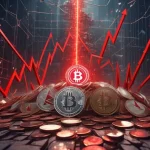European Founders Turn to Tokenization Amid VC Funding Decline: Regulatory Hurdles Persist

Tokenization: A Backdoor Funding Strategy for European Founders
Europe’s venture capital market is contracting, with a 36% quarterly drop in 2024, leaving founders in search of new funding avenues. Tokenization emerges as a promising alternative, allowing companies to issue digital shares on the blockchain. However, regulatory barriers in Europe threaten to stifle this innovation.
- Declining VC market in Europe
- Tokenization as a funding alternative
- Regulatory hurdles in Europe
- More favorable jurisdictions for tokenization
The European venture capital landscape is under strain, with a significant decline in funding reaching its lowest point since Q3 2020. This downward trend has left many founders searching for innovative ways to secure the capital they need. Tokenization, the process of converting rights to an asset into a digital token on a blockchain, is becoming an attractive alternative. Ross Shemeliak, co-founder and COO at Stobox, describes it as a ‘backdoor’ into funding: “For entrepreneurs across the globe, tokenization allows companies to steer clear of VCs, who can be pretty picky and demanding.”
Tokenization offers several advantages for European founders. It opens the door to a diverse pool of investors worldwide, not just the traditional venture capitalists. It also provides a more flexible and efficient way to manage equity and distribute dividends. Imagine if you could turn your company’s shares into digital tokens—suddenly, the world becomes your oyster, and your startup could be the next big thing in the tokenized ecosystem.
However, Europe’s regulatory environment poses significant challenges. European corporate law requires physical notarization and public company registration—requirements that seem almost quaint in the digital age. These hurdles are absent in more progressive jurisdictions like the United States, Singapore, MENA countries, the British Virgin Islands, Switzerland, and Lichtenstein. These countries benefit from low barriers to entry, exemptions for foreign securities offerings, and supportive corporate laws, making them attractive for tokenization.
The Markets in Crypto-Assets Regulation (MiCA), implemented in phases starting in June 2024, further complicates matters. While MiCA aims to regulate crypto and stablecoins, it largely excludes real-world asset (RWA) tokenization. This regulatory focus is a missed opportunity for Europe, especially when considering the region’s underinvestment in tech—€700 billion annually between 2015 and 2022, according to the World Economic Forum.
“Europe is also held back by the lack of a uniform threshold for issue sizes.”
Ross Shemeliak critiques Europe’s fragmented and restrictive approach, stating the above. This stance hinders the potential for tokenization to drive investment and economic growth in the region. He adds, “We can see that Europe is lagging behind in tokenization. Clearly, European corporate law needs to be refined in favor of tokenization and securities on the blockchain.”
Despite these challenges, tokenization has proven successful elsewhere. For instance, Singapore’s Monetary Authority (MAS) has actively promoted tokenized assets through initiatives like Project Guardian. Leong Sing Chiong from MAS highlights the strong interest in asset tokenization in fixed income, FX, and asset management, showcasing the potential for tokenization to revolutionize traditional markets.
Europe could learn from these examples. Tokenization offers a direct investment channel for private companies, which could significantly boost investment activity and economic growth across the continent. Yet, without regulatory reform, European founders may continue to look elsewhere for more favorable environments to launch their tokenized ventures.
The future of tokenization in Europe hinges on regulatory adaptation. Will Europe embrace this innovation, or will it watch as its founders seek greener pastures? The answer could shape the future of innovation and investment in the region. Tokenization might just be the superhero cape European founders need to leap over the dwindling VC market.
While tokenization offers a promising funding alternative, it’s not without risks. Increased regulatory scrutiny and the volatility of digital assets could pose challenges. However, as part of the broader cryptocurrency ecosystem, tokenization complements Bitcoin’s role as the cornerstone of digital currency, providing a tool for funding innovation that Bitcoin itself might not serve directly.
Key Takeaways and Questions
- What challenges do European founders face in raising funds?
European founders face a declining VC market, with a 36% quarterly drop in 2024, and funding reaching its lowest since Q3 2020.
- How does tokenization serve as a ‘backdoor’ for funding?
Tokenization allows companies to bypass traditional VCs and access a diverse pool of investors by issuing digital shares on the blockchain.
- What regulatory hurdles does Europe face in adopting tokenization?
Europe faces challenges such as restrictive corporate laws, the need for physical notarization, and the lack of a uniform threshold for issue sizes, which hinder tokenization adoption.
- Which countries are leading in tokenization and why?
The US, Singapore, MENA countries, the British Virgin Islands, Switzerland, and Lichtenstein lead due to low barriers to entry, exemptions for foreign securities offerings, and supportive corporate laws.
- How does the MiCA regulation impact tokenization in Europe?
The MiCA regulation focuses on crypto and stablecoins, largely excluding RWA tokenization, which complicates the regulatory landscape for tokenization in Europe.
- What opportunities does tokenization present for Europe’s economy?
Tokenization presents opportunities for direct investment in private companies, potentially boosting investment activity and economic growth across Europe.



